1
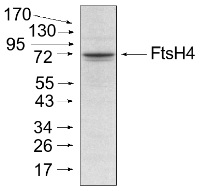
Anti-FtsH4 | ATP-dependent zinc metalloprotease FtsH4 (mitochondrial)
AS07 205 | Clonality: Polyclonal | Host: Rabbit | Reactivity: Arabidopsis thaliana
- Product Info
-
Immunogen: KLH-conjugated peptide derived from sequence of Arabidopsis thaliana FtsH4 UniProt: O80983, TAIR: At2g26140
Host: Rabbit Clonality: Polyclonal Purity: Immunogen affinity purified serum in PBS pH 7.4. Format: Lyophilized Quantity: 200 µg Reconstitution: For reconstitution add 100 µl of sterile water Storage: Store lyophilized/reconstituted at -20°C; once reconstituted make aliquots to avoid repeated freeze-thaw cycles. Please remember to spin the tubes briefly prior to opening them to avoid any losses that might occur from material adhering to the cap or sides of the tube. Tested applications: Western blot (WB) Recommended dilution: 1 : 500 (WB) Expected | apparent MW: 77 | 72 kDa
- Reactivity
-
Confirmed reactivity: Arabidopsis thaliana, Brassica oleracea var. botrytis Predicted reactivity: Brassica sp.
Species of your interest not listed? Contact usNot reactive in: Solanum lycopersicum - Application Examples
-
Application example 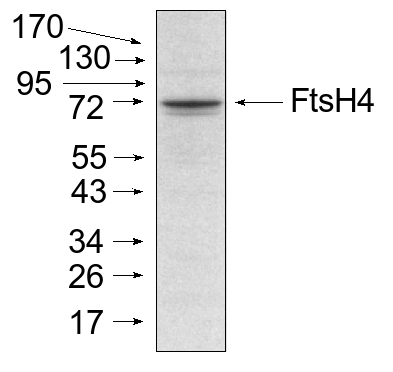
Total protein from Arabidopsis thaliana mitochondria (20 µg) were separated on 10% acrilamide gel and electrophoresis prepared according to Schägger and von Jagov (Anl. Biochem., 1987, 166:368-379). After running the gel, proteins were transferred to nitrocellulose membrane using wet transfer (0.22% CAPS, pH 11). Transfer was checked by Ponceau S staining. Blot was destained by several quick washings in distilled water and 1 washing in 1X TBS (10 mM T pH 7.5, 150 mM NaCl) (10-15 min.).Blot was blocked by 1.5 hour in 5% milk in TBST (1X TBS, 0,1 20) After blocking blot was washed quickly twice in TBST and incubated 2 hours with primary antibody (dilution 1: 1000 TBST (dilution 1:1000). Washing: two quick washings in TBST and 3 x 10 min. washings in TBST. Then blot was incubated 45-60 min. with a secondary anti-rabbit antibodies conjugated to peroxidase (dilution 1:10000) in TBST. Washing: as above. After washing blot was incubated 1-2 min. in chemiluminescent solution and exposed to Kodak autoradiography film. Exposure time was 15-60 seconds.
Mitochondria were isolated as described by Urantowka et al. (Plant Mol Biol, 2005, 59:239-52). Mitochondrial pellets were suspended in 1X Laemmli buffer (5% beta-mercaptoetanol, 3.7% glycerol, 1.1% SDS, 23 mM Tris-HCl pH 6.8, 0.01% bromophenol blue), heated (95ºC, 5 min.) and centrifuged (13000rpm, 1 min.).
Courtesy Dr. J. Piechota, University of Wrocław, Poland
Application examples: 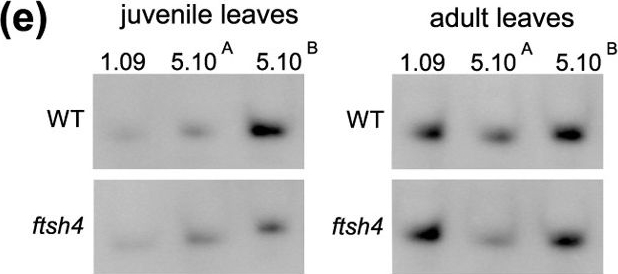
Reactant: Arabidopsis thaliana (Thale cress)
Application: Western Blotting
Pudmed ID: 27321362
Journal: Sci Rep
Figure Number: 4E
Published Date: 2016-06-20
First Author: Dolzblasz, A., Smakowska, E., et al.
Impact Factor: 4.13
Open PublicationInternal oxidative stress accumulation in ftsh4 mutant plants grown at 30?°C.(a) NBT assay showing the accumulation of superoxide radicals O?? (dark blue colour) in adult and flowering wild-type and ftsh4 mutant plants. (b) Expression level of the oxidative stress marker, UPOX, in the shoot apices (SAM and the youngest primordia), measured in different developmental stages: juvenile, adult, 1?cm high young flowering plant, and additionally for the WT also mature (c. 15?cm high) plants grown at 30?°C. Transcript levels for gene encoding UPOX in ftsh4 mutants are shown relative to WT plants. Mean values?±?SD from three experiments are shown. Asterisks denote significant differences from the juvenile sample at p?
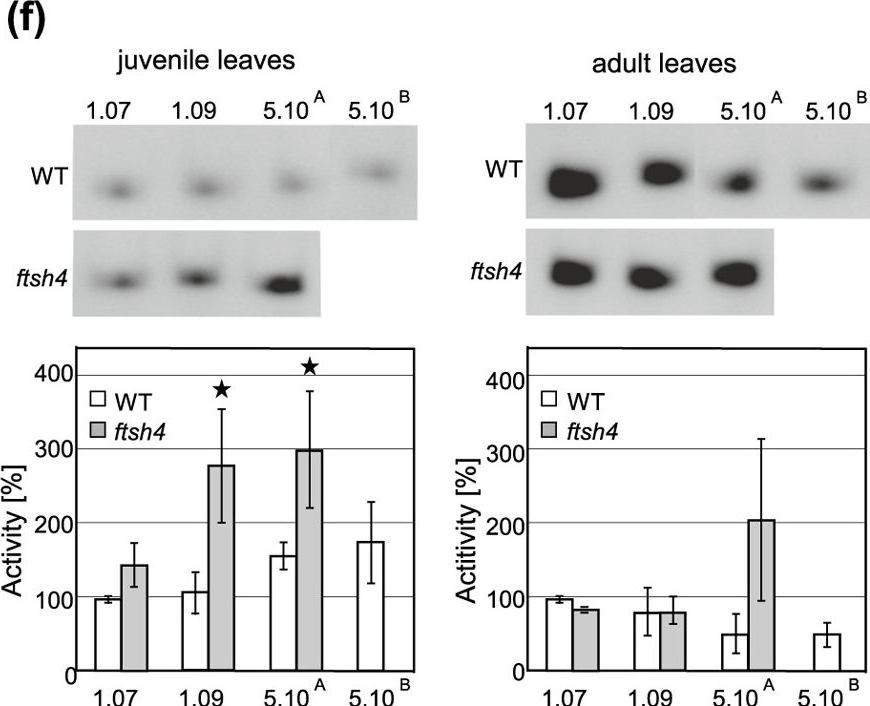
Reactant: Arabidopsis thaliana (Thale cress)
Application: Western Blotting
Pudmed ID: 27321362
Journal: Sci Rep
Figure Number: 4F
Published Date: 2016-06-20
First Author: Dolzblasz, A., Smakowska, E., et al.
Impact Factor: 4.13
Open PublicationInternal oxidative stress accumulation in ftsh4 mutant plants grown at 30?°C.(a) NBT assay showing the accumulation of superoxide radicals O?? (dark blue colour) in adult and flowering wild-type and ftsh4 mutant plants. (b) Expression level of the oxidative stress marker, UPOX, in the shoot apices (SAM and the youngest primordia), measured in different developmental stages: juvenile, adult, 1?cm high young flowering plant, and additionally for the WT also mature (c. 15?cm high) plants grown at 30?°C. Transcript levels for gene encoding UPOX in ftsh4 mutants are shown relative to WT plants. Mean values?±?SD from three experiments are shown. Asterisks denote significant differences from the juvenile sample at p?
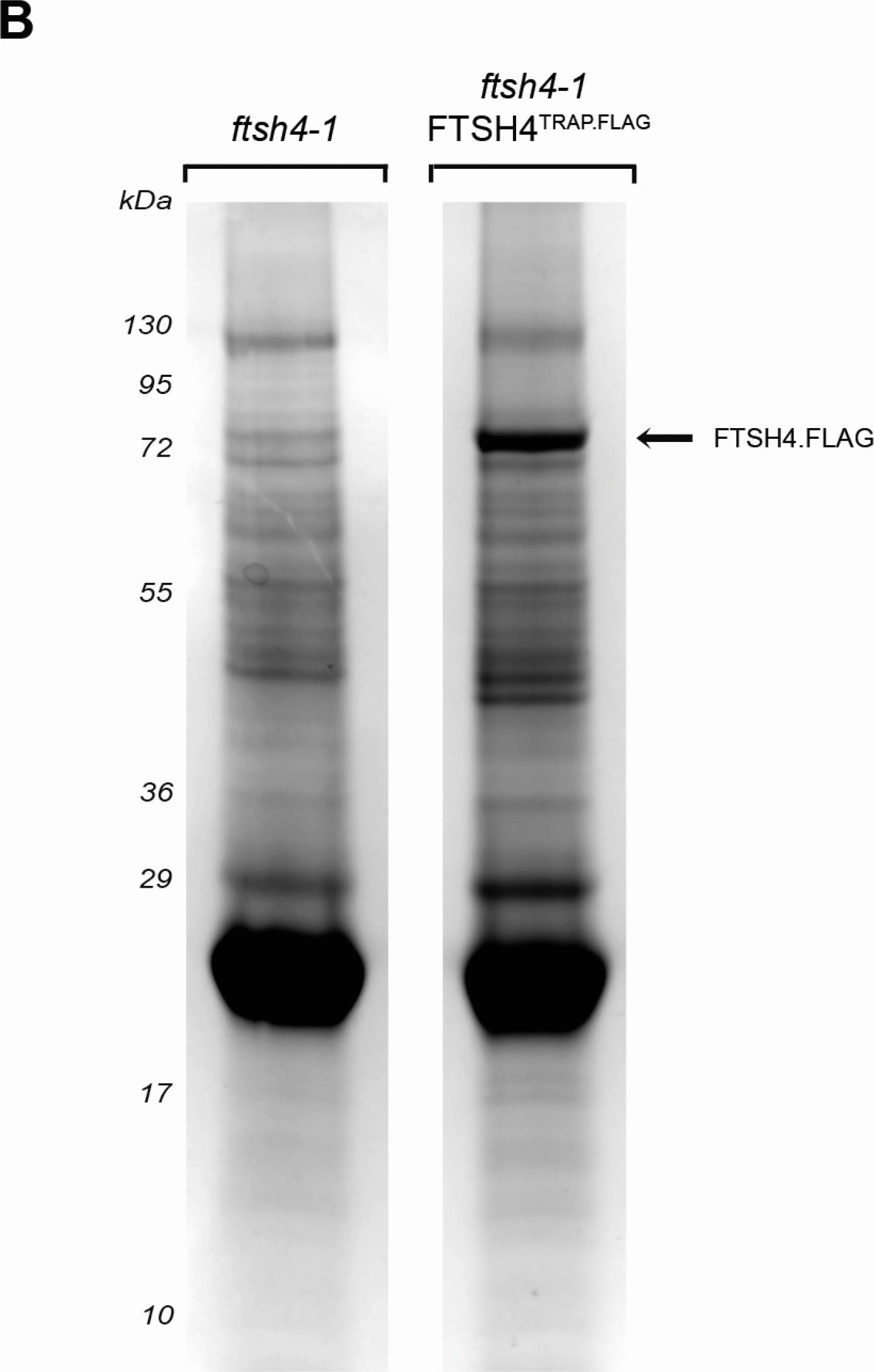
Reactant: Arabidopsis thaliana (Thale cress)
Application: Western Blotting
Pudmed ID: 29156584
Journal: Int J Mol Sci
Figure Number: 1B
Published Date: 2017-11-18
First Author: Opali?ska, M., Parys, K., et al.
Impact Factor: 5.542
Open PublicationFTSH4 substrate trapping assay (A) Overview of FTSH4 substrate-trapping assay. Cartoon illustrating the experimental workflow; (B) Eluted fractions resolved on SDS-PAGE and stained with CBB. IMS—intermembrane space.

Reactant: Arabidopsis thaliana (Thale cress)
Application: Western Blotting
Pudmed ID: 29156584
Journal: Int J Mol Sci
Figure Number: 2A
Published Date: 2017-11-18
First Author: Opali?ska, M., Parys, K., et al.
Impact Factor: 5.542
Open PublicationImmunoblot analysis of FTSH4 substrate trapping assay samples. Mitochondria from control (ftsh4-1) and ftsh4-1 FTSH4TRAP.FLAG were solubilized with digitonin and subjected to immunoprecipitation with anti-FLAG affinity matrix. The precipitated proteins were immunoblotted with antibodies against the indicated proteins. IN—input (5%), FT—flow-through (5%), W—Wash, E—eluate (50%).
- Background
-
Background: One of the several classes of mitochondrial proteases is membrane bound, ATPdependent FtsH protease. Their function is very important for the control of protein quality and quantity by degradation of unassembled subunits. Synonyme: cell division protease ftsH homolog 4, mitochondrial
- Product Citations
-
Selected references: Opalińska et al. (2017). Identification of Physiological Substrates and Binding Partners of the Plant Mitochondrial Protease FTSH4 by the Trapping Approach. Int J Mol Sci. 2017 Nov 18;18(11). pii: E2455. doi: 10.3390/ijms18112455.
Dolzblasz et al. (2016). The mitochondrial protease AtFTSH4 safeguards Arabidopsis shoot apical meristem function. Sci Rep. 2016 Jun 20;6:28315. doi: 10.1038/srep28315.
Rurek et al. (2015). Biogenesis of mitochondria in cauliflower (Brassica oleracea var. botrytis) curds subjected to temperature stress and recovery involves regulation of the complexome, respiratory chain activity, organellar translation and ultrastructure. Biochim Biophys Acta. 2015 Jan 21. pii: S0005-2728(15)00016-X. doi: 10.1016/j.bbabio.2015.01.005.
Zhang et al. (2014). Perturbation of auxin homeostasis caused by mitochondrial FtSH4 gene-mediated peroxidase accumulation regulates Arabidopsis architechture. Mol Plant. 2014 Jan 30.
Kwasniak et al. (2013). Silencing of the Nuclear RPS10 Gene Encoding Mitochondrial Ribosomal Protein Alters Translation in Arabidiopsis Mitochondria. Plant Cell, May 30.
- Protocols
-
Agrisera Western Blot protocol and video tutorials
Protocols to work with plant and algal protein extracts - Reviews:
-
Michal RUREK | 2014-02-1415 µg of mitochondrial proteins from cauliflower (Brassica oleracea var. botrytis) curds (apical layer) was separated on 12 % SDS-PAGE (Laemmli- type) and blotted 1h to Immobilone P (Millipore) using Sedryt apparatus (Kucharczyk). After blocking (5% milk in PBS-T) for 1 h at RT, blots were incubated in the primary antibody at a dilution of 1: 5000 for overnight at 4 deg. with agitation. The primary antibody, diluted in 2% milk in PBS-T was reused several times. Secondary, anti-rabbit HRP- linked antibodies were bound at 1/10000 dilution at RT (1h). Single band of ca. 80 kDa was detected using standart GE Healthcare ECL reagents.
Accessories

AS11 1789 | Clonality: Polyclonal | Host: Rabbit | Reactivity: A. acetabulum, A. thaliana, B. hypnoides (ulvophytes), G. theta, H. vulgare, Synechocystis sp., T. pseudonana, Z. mays
Benefits of using this antibody


